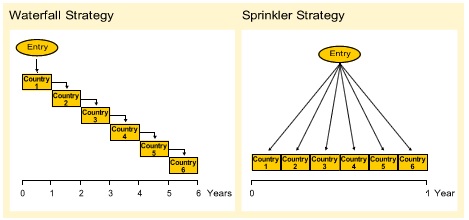Marketing Strategy For Business expansion In International Market

Staring your business expansion in a foreign land could be tricky & getting a right strategy could help you achieve that objective. But we marketers need to choose wisely which module could play advantage to our court. Here will discuss two factors with their respective advantages & disadvantages.
1) Waterfall Strategy
2) Sprinkler Strategy

Waterfall market entry strategy is a consecutive business expansion to foreign markets. Its main characteristic is the use of clearly defined entry stages and the sequential use of experience: as per the above, you can state that growth is stepwise regardless of years.
In this module, each stage is exhibited footsteps in the foreign market. First, a company enters one foreign market, establishes itself, promotes the product and builds a client base. After a successful establishment regardless of years, the company moves into another step acquiring previous knowledge & confidence to go ahead.
This strategy resembles a waterfall, where water gushes through each stage before it reaches the final destination.
Implementation
This marketing strategy is compatible for those companies, whose produce products with a longer life cycle or products which are in maturity phase. Waterfall market strategy implies in establishing and building up a client base for long life cycle duration ensuring that the product is not removed from the market before the prospects of the business is stable. Product which is in the maturity phase ensures that by the time company enters into foreign market, the product is ready to be sold.
If it gains enough popularity, the product's lifecycle across all the markets will be prolonged. Another point to consider with waterfall market entry strategy is the choice of foreign market. Initially, it is advisable to choose a foreign market that is very similar to a company's domestic one. This minimizes the number of risks, such as consumer purchasing culture discrepancy risk and the risk incurred by different currencies. After cementing a stronghold in foreign market, a company can take the next step by incorporating into another market that can be similar to either the domestic one or the previous one. Such a gradual approach ensures a smooth transition, as the business environment of a new market will never be drastically unfamiliar. Exotic foreign markets are a lot more understandable if they are approached through other markets, gradually transitioning from familiar to unfamiliar.
Advantages
The waterfall market entry strategy transforms products into their maturity stage, prolonging their life-cycle while maintaining a stable position within the market. As only one market is entered at a time, all the business expansion resources are concentrated there, which minimizes risks. Besides that, as markets are chosen so that each next one resembles the previous one, the transition to farther, more exotic markets happens more gradually, without incurring additional risks connected with unfamiliar business environments.
Waterfall strategy being one of clearer path for those who are in for long run & training themselves and adjusting to new audience & marketing structure. Every country entered requires in-depth analysis of getting new products or mature products into sale. Waterfall market entry is also distinguished by the accumulation of business expansion knowledge.
Business skills from domestic market are used to incorporate in the first foreign market. The additional knowledge gained there is used in the market, and the process is repeated for as many times as different foreign markets is been entered. Such an accumulation of knowledge of business expansion knowledge allows making the risks smaller for each entry, which makes the waterfall strategy especially advantageous in the long run, being suited for businesses that plan to enter a significant number of markets.
Disadvantages
As the waterfall market strategy implies entering only one foreign market at a time, it leaves little room for failure. If a business is forced to withdraw from a foreign market at the initial entry stages, the losses are comparatively small. If the company, however, has already invested significant resources in establishing itself, the costs of withdrawing increase significantly, and at the same time the company has no alternatives in other foreign markets. This is somewhat compensated, if a new foreign market is not the first, and the company has a solid background in other foreign markets, but this applies only to highly internationalized companies.
Another disadvantage is that a business potentially loses its first-mover advantage on other foreign markets, as it simply does not enter them. Competitors can enter other markets faster than the business in question establishes itself in a certain foreign market and is ready to expand elsewhere.
Sprinkler Strategy
The sprinkler market entry strategy is simultaneous business expansion to a number of foreign markets. Its main characteristic is the simultaneous market entry in pursuit of benefits that an early entry provides. Thus, it is a high-risk, high-reward approach - a successfully executed sprinkler strategy allows collecting profits from several markets while also being ahead of your competition, but a failed entry (withdrawal from markets) costs a lot of resources and provides little in terms of compensation.
A company enters several foreign markets at once and tries to establish itself, promote the product and build a client base simultaneously. The company receives profit and internationalization knowledge from several markets, which makes spreading the business even more effective, as there are so many sources of resources and information. This is similar to a water sprinkler, where each individual droplet is small, but they are numerous and spread all around, so that all the nearby area is watered evenly and thoroughly.
Implementation
The sprinkler market entry strategy is best suited for companies, who produce products with a short life cycle or whose products are in the introduction or growth phase. Usually the sprinkler strategy is supplemented by the price skimming technique, when the initial price is rather high and is lowered with time. This allows generating as much profits as possible in a relatively short period of time, taking into consideration profits from all the regional branches.
Another thing to keep in mind with the sprinkler market entry is the procedure standardization. As it is almost impossible to customize and adapt for each and every market entered, standardization plays an important role in keeping the business expansion process coherent and the incoming data comparable. Of course, it does not mean that everything should be uniform - it is still vital to pay attention to, for example, cultural differences and how they affect advertising and branding. Thus, for example, hot dog companies in Malaysia in 2016 were forced to rename their products concerning the word 'dog', as this animal is considered to be 'unclean' in Islam, which is one of the major religions of the region. If the sprinkler strategy fails to adapt to such peculiarities, expansion into a certain market may stall.
Advantages
The sprinkler market entry strategy is an effective method of outrunning competition and utilizing the first-mover or technological advantage. While the competitors enter just one or two markets at a time, the business in question raises the brand-awareness in many more markets. Even if the competitors also enter these markets, they will be seen as followers, rather than as innovators. The business that uses the sprinkler market entry strategy has more time to analyze the market and make adjustments. An early simultaneous entry also means more possibilities for registering intellectual property, which hinders the later advance of competitors even more.
Another advantage is the amount of income from a large number of entered market, especially if the business expansion was successful in the majority of the markets. Besides just receiving profits and using them to develop the company, this also gives another advantage - the profits from successfully entered markets can be allocated to less successful regional branches, thus minimizing the risk of withdrawal across all the markets. This makes the sprinkler strategy advantageous in the long-run.
Disadvantages
The sprinkler market entry relies on a big number of markets entered simultaneously, which, in turn, requires a significant amount of initial investments. This includes both finances and staff, as well as the general business expansion planning. Depending on the markets and other circumstances, production facilities, offices, logistics networks and bank accounts will need to be established in numerous markets at once, putting additional strain on resources.
Another disadvantage of the sprinkler strategy is the high risk of entering a number of markets at once. Although a failure and possible withdrawal in one can be compensated by the profits from other markets, if the whole business expansion is unsuccessful, the losses are rather serious (due to big initial investments, see the previous disadvantage).

